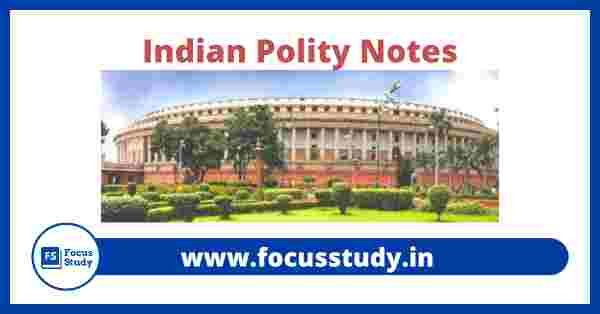सामान्य प्रतियोगी परीक्षाओ में भारतीय राज्यव्यवस्था का महत्वपूर्ण भाग है | SSC CGL, SSC CHSL, RRB NTPC, RRB GROUP D, STATE PCS और अन्य प्रतियोगी परीक्षाओ में भारत के राज्यव्यवस्था से प्रश्न पुछे जाते हैं | इस पोस्ट में हम आपको भारतीय राज्यव्यवस्था (Indian Polity notes) से संक्षिप्त नोट्स प्रदान करने जा रहें हैं | यह आपकी परीक्षा की तयारी में आपके लिए बहुत उपयोगी होगी |

Preamble
We, the people of India, having solemnly
resolved to constitute India into a Sovereign
Socialist Secular Democratic Republic
and to secure to all its citizens:
Justice, Social, economic and political,
Liberty of thought, expression, belief, faith and worship;
Equality of status and of opportunity;
and to promote among them all.
Fraternity assuring the dignity of the
individual and the Unity and Integrity of the nation;
In our constituent assembly this 26th day of Nov 1949, do hereby adopt, enact and give to ourselves this constitution.
Note: Word preamble took from the USA.
भारतीय संविधान का विकास
1934: Idea of the constituent assembly given by MN Roy.
1935: INC (Indian Nation Congress) demanded it officially.
1935: Accepted in August offer.
1946: Constituted under cabinet mission plan.
Number of Members during the constitution of India
296+93= 389
296 members come from Provinces state and 93 members come from Princely state.
Women member in constitution assembly = 9
- The first meeting of the constitutional assembly is 9 Dec 1946.
- Dr. Sachidanand Sinha as 1st president of Constitutional Assembly, on basis of most aged.
- 11 Dec 1946 (2nd Meeting)
Dr. Rajendra Prasad – President
Vice President – HC Mukherjee
Advisor – B.N.Roy
- 13 Dec 1946 ( 3rd Meeting)
Objective Resolution presented by JL Nehru.
Committees:-
Drafting Committee – BR Ambedkar
Union Power – JL Nehru
Union Constitution – JL Nehru
State Committee – JL Nehru
Advisory Committee on
The fundamental right of – Sardar Patel
Minorities
Provincial Constitution – Sardar Patel
Rules of Procedure – Dr.Rajendra Prasad
The Indian constitution was completed in 2 years 11 Months 18 days.
On the same day, National Symbol is accepted
24 Jan 1950: Last meeting
National Anthem and National Song are adopted at the last meeting.
Dr. Rajendra Prasad as 1st president of India.
Structure:-
Part – 22
Schedules – 08
Articles – 395
Now in Present 25 Parts, 12 Schedules, 448 Articles
Salient features of Indiana constitution
- Lenghtiest written constitution.
- Blend of Rigidity & flexibility
- Parliamentary form of Govt.
- A federal system with unitary bias.
- Secular state.
- Welfare state.
- Emergency provision
Important Sources:-
Britain
- Parliamentary form of govt.
- Bicameralism.
- Rule of law.
- Office of CAG
- Single Citizenship
USA
- Fundamental Rights.
- Judicial review.
- Independence of Judiciary.
- Written constitution
RUSSIA
- Fundamental duties
Ireland
- DPSP (Directive principle of state policy)
Canada
- Federal System.
- Residual power.
Australia
- Concurrent list
Germany
- Suspension of Fundamental rights during Emergency.
South Africa
- Constitutional amendment
Important Part of Indian constituent
Part 1: Union and its territories (Art. 1to 4)
Art.1: India, that is Bharat, shall be a union of state.
Art.3: State reorganization bill, Alteration of areas, boundaries, or name of the existing state.
Part 2: Citizenship (Art. 5 to 11)
Part 3: Fundamental Rights (12 to 35)
- Right to equality.
- Right to freedom.
- Right against exploitation.
- Right to freedom of religion.
- Cultural and educational rights.
- Right to constitutional remedies.
Note: Right to property- Change to legal right -1978 44th amendments
- Right to equality (Art. 14 to 18)
Art. 14: Equality before law.
Art. 15: Prohibition of discrimination on grounds of religion, race caste, sex, or place of birth
Art.16: Equality of opportunity in public employment.
Art. 17: Abolition of untouchability.
Art. 18: Abolition of titles.
- Right to freedom. (Art. 19 to 22)
Art. 19: Freedom of speech, expression assembles peacefully, from the association, move freely, and settle anywhere, any profession.
- No ex post-Facto
- No double Jeopardy.
- No self incrimination.
Art. 21: Protection of life & personal liberty.
- Right to Live with human dignity
- Right to Decent environment
- Right to Privacy
- Right to Health
- Right to free legal aid
- Right to Fair trial
- Right to Information
- Right to Women to be treated with dignity
- Right to Emergency medical aid.
Note: – Art. 21A: Right to education added to all (6 to 14 years) child under 86th amendments in 2002
Right against exploitation (Art. 23to 24)
Art. 23: Prohibition of traffic in Human beings and forced labor.
Art. 24: Prohibits child labor.
Right to freedom of religion (Art. 25to 28)
Art. 25: Freedom to profess, practice, and propagate any religion.
Art. 26: Freedom to manage religious affairs.
Art. 27: Freedom from taxation on the promotion of religion
Art.28: Freedom from attending religious instruction.
Cultural and educational rights (Art. 29 to 30)
Art. 29: Protection of interest minorities.
Art. 30: Right of minorities to establish and administer educational institutions.
Right to constitutional remedies (Art.32)
Art.32: Heart and Soul of the Constitution.
DPSP: Directive principle of state Policy. (Art. 36 to 51)
- Directions/ instruction to state.
- Non-Justiciable.
- Fundamental to governance.
- Source: Irish constitution.
Art. 38: State to secure a social order for the promotion of the welfare of people.
Art.39A: Equal justice and free legal aid.
Art. 40: Organization of village panchayats
Art. 42: Just and humane conditions of work and maternity relief.
Art.44: Uniform civil code.
Art.45: Free and compulsory education for children.
Art.48: Organization of agriculture and animal husbandry.
Art.49: Protection of monuments and places and objects of national importance.
Some important Articles
President
| Article no. | Post |
| 52 | राष्ट्रपति का पद |
| 53 | कार्य एंव शक्ति |
| 54 | निर्वाचन |
| 61 | महाभियोग |
| 72 | श्रमा दान |
| 85 | लोक सभा का विघटन |
| 123 | अध्यादेश |
| 143 | supreme court से सलाह |
Vice President
| Article no. | Post |
| 63 | पद |
| 64/89 | राज्य सभा की सभापति |
Priminister
| Article no. | Post |
| 74 | मंत्री परिषद |
| 75 | प्रधानमंत्री |
संसद
| Article no. | Post |
| 79 | संसद की चर्चा |
| 80 | राज्यसभा |
| 81 | लोकसभा |
| 100 | अध्यक्ष महोदय का निर्णायक मत |
| 105 | संसदीय विशेषाधिकार |
| 108 | संयुक्त अधिवेशन |
| 110 | धन विधयेक |
| 112 | बजट |
| 116 | लेखा अनुदान |
| 117 | वित्र विधयेक |
Supreme Court
- 124- गठन
- 131- क्षेत्राधिकार
- 137- न्यायिक पुनः विलोकन
- 143- superme court राष्ट्रपति को सलाह दे सकता है |
राज्यपाल
| Article no. | Post |
| 152 | परिभाषा |
| 153 | राज्यों के लिए राज्यपाल |
| 154 | शक्ति एंव कार्य |
| 155 | निर्वाचन |
| 161 | क्षमादान |
मंत्रिपरिषद
| Article no. | Post |
| 163 | मंत्रिपरिषद |
| 164 | मुख्यमंत्री |
| 165 | महाधिवक्ता |
